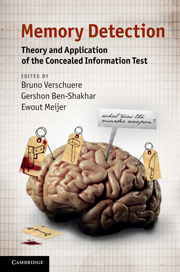Book contents
- Frontmatter
- Contents
- List of figures
- List of tables
- Notes on contributors
- Acknowledgments
- Part I Introduction
- Part II The laboratory: theoretical and empirical foundations of the Concealed Information Test
- 2 Detecting concealed information using autonomic measures
- 3 Detecting concealed information in less than a second: response latency-based measures
- 4 P300 in detecting concealed information
- 5 Detecting of deception and concealed information using neuroimaging techniques
- 6 New and old covert measures in the Concealed Information Test
- 7 Theory of the Concealed Information Test
- Part III Field applications of concealed information detection: promises and perils
- Part IV Conclusions
- Index
- References
6 - New and old covert measures in the Concealed Information Test
Published online by Cambridge University Press: 05 June 2012
- Frontmatter
- Contents
- List of figures
- List of tables
- Notes on contributors
- Acknowledgments
- Part I Introduction
- Part II The laboratory: theoretical and empirical foundations of the Concealed Information Test
- 2 Detecting concealed information using autonomic measures
- 3 Detecting concealed information in less than a second: response latency-based measures
- 4 P300 in detecting concealed information
- 5 Detecting of deception and concealed information using neuroimaging techniques
- 6 New and old covert measures in the Concealed Information Test
- 7 Theory of the Concealed Information Test
- Part III Field applications of concealed information detection: promises and perils
- Part IV Conclusions
- Index
- References
Summary
Overview: In the concealed information polygraph test, suspects are well aware that they are being interrogated and that their physiological responses are being monitored. Such awareness may result in countermeasure attempts by guilty suspects while trying to escape detection. To combat countermeasures, it is possible to remove the standard polygraph sensors and replace them with covert respiration measures. The rationale is that guilty suspects would shift attention from their physiological reaction to the more familiar verbal and facial expressions. The present chapter introduces covert respiration measures and describes how they can be used to reduce countermeasures. Another question is whether covert respiration measures may serve to reduce excitement of overexcited examinees. The issue is further discussed. Attention is also given to early attempts to apply covert voice analysis and to more recent attempts to measure thermal imaging from a distance. Finally, ethical and moral considerations involved in using covert measures are discussed.
A well studied polygraph interrogation format, the Concealed Information Test (CIT) is designed to detect information that an individual tries to conceal (Lykken, 1974, 1998). Normally, suspects are presented with a series of multiple-choice questions, each having one correct alternative (e.g., a feature of the crime under investigation) and several incorrect (control) alternatives, chosen so that an innocent person would not be able to discriminate them from the correct alternative (Lykken, 1998).
- Type
- Chapter
- Information
- Memory DetectionTheory and Application of the Concealed Information Test, pp. 114 - 127Publisher: Cambridge University PressPrint publication year: 2011
References
- 1
- Cited by



